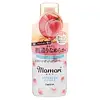What's inside
What's inside
 Key Ingredients
Key Ingredients

No key ingredients
 Benefits
Benefits

 Concerns
Concerns

 Ingredients Side-by-side
Ingredients Side-by-side

Water
Skin ConditioningPropylene Glycol
HumectantDimethicone
EmollientMyristyl Alcohol
EmollientButylene Glycol
HumectantAlcohol Denat.
AntimicrobialEthylhexylglycerin
Skin ConditioningGamma-Docosalactone
Skin ConditioningGlycerin
HumectantSteartrimonium Chloride
PreservativeCaprylic/Capric Triglyceride
MaskingHydroxyethylcellulose
Emulsion StabilisingPhenoxyethanol
PreservativeBehentrimonium Chloride
PreservativePrunus Persica Fruit Extract
AbrasiveDisodium EDTA
Aroma
Water, Propylene Glycol, Dimethicone, Myristyl Alcohol, Butylene Glycol, Alcohol Denat., Ethylhexylglycerin, Gamma-Docosalactone, Glycerin, Steartrimonium Chloride, Caprylic/Capric Triglyceride, Hydroxyethylcellulose, Phenoxyethanol, Behentrimonium Chloride, Prunus Persica Fruit Extract, Disodium EDTA, Aroma
Water
Skin ConditioningDimethicone
EmollientCetearyl Alcohol
EmollientNeopentyl Glycol Diethylhexanoate
EmollientIsopentyldiol
HumectantGlycine Soja Sterols
EmollientDihydroxymethylsilylpropoxy Hydroxypropyl Hydrolyzed Casein
Skin ConditioningIsodecyl Neopentanoate
EmollientPEG-12 Dimethicone
Skin ConditioningMaltitol
HumectantArginine
MaskingGlycine
BufferingAspartic Acid
MaskingSerine
MaskingThreonine
Valine
MaskingAlanine
MaskingProline
Skin ConditioningPhenylalanine
MaskingIsoleucine
Skin ConditioningHistidine
HumectantPCA
HumectantSodium PCA
HumectantSodium Lactate
BufferingSorbitol
HumectantPPG-10 Methyl Glucose Ether
Skin ConditioningPhenyl Trimethicone
Skin ConditioningBehentrimonium Methosulfate
Butylene Glycol
HumectantHydroxypropyl Methylcellulose Stearoxy Ether
Glyceryl Stearate
EmollientCetrimonium Chloride
AntimicrobialCitric Acid
BufferingDisodium EDTA
Phenoxyethanol
PreservativeWater, Dimethicone, Cetearyl Alcohol, Neopentyl Glycol Diethylhexanoate, Isopentyldiol, Glycine Soja Sterols, Dihydroxymethylsilylpropoxy Hydroxypropyl Hydrolyzed Casein, Isodecyl Neopentanoate, PEG-12 Dimethicone, Maltitol, Arginine, Glycine, Aspartic Acid, Serine, Threonine, Valine, Alanine, Proline, Phenylalanine, Isoleucine, Histidine, PCA, Sodium PCA, Sodium Lactate, Sorbitol, PPG-10 Methyl Glucose Ether, Phenyl Trimethicone, Behentrimonium Methosulfate, Butylene Glycol, Hydroxypropyl Methylcellulose Stearoxy Ether, Glyceryl Stearate, Cetrimonium Chloride, Citric Acid, Disodium EDTA, Phenoxyethanol
 Reviews
Reviews

Ingredients Explained
These ingredients are found in both products.
Ingredients higher up in an ingredient list are typically present in a larger amount.
Butylene Glycol (or BG) is used within cosmetic products for a few different reasons:
Overall, Butylene Glycol is a safe and well-rounded ingredient that works well with other ingredients.
Though this ingredient works well with most skin types, some people with sensitive skin may experience a reaction such as allergic rashes, closed comedones, or itchiness.
Learn more about Butylene GlycolDimethicone is a type of synthetic silicone created from natural materials such as quartz.
What it does:
Dimethicone comes in different viscosities:
Depending on the viscosity, dimethicone has different properties.
Ingredients lists don't always show which type is used, so we recommend reaching out to the brand if you have questions about the viscosity.
This ingredient is unlikely to cause irritation because it does not get absorbed into skin. However, people with silicone allergies should be careful about using this ingredient.
Note: Dimethicone may contribute to pilling. This is because it is not oil or water soluble, so pilling may occur when layered with products. When mixed with heavy oils in a formula, the outcome is also quite greasy.
Learn more about DimethiconeDisodium EDTA plays a role in making products more stable by aiding other preservatives.
It is a chelating agent, meaning it neutralizes metal ions that may be found in a product.
Disodium EDTA is a salt of edetic acid and is found to be safe in cosmetic ingredients.
Learn more about Disodium EDTAPhenoxyethanol is a preservative that has germicide, antimicrobial, and aromatic properties. Studies show that phenoxyethanol can prevent microbial growth. By itself, it has a scent that is similar to that of a rose.
It's often used in formulations along with Caprylyl Glycol to preserve the shelf life of products.
Water. It's the most common cosmetic ingredient of all. You'll usually see it at the top of ingredient lists, meaning that it makes up the largest part of the product.
So why is it so popular? Water most often acts as a solvent - this means that it helps dissolve other ingredients into the formulation.
You'll also recognize water as that liquid we all need to stay alive. If you see this, drink a glass of water. Stay hydrated!
Learn more about Water